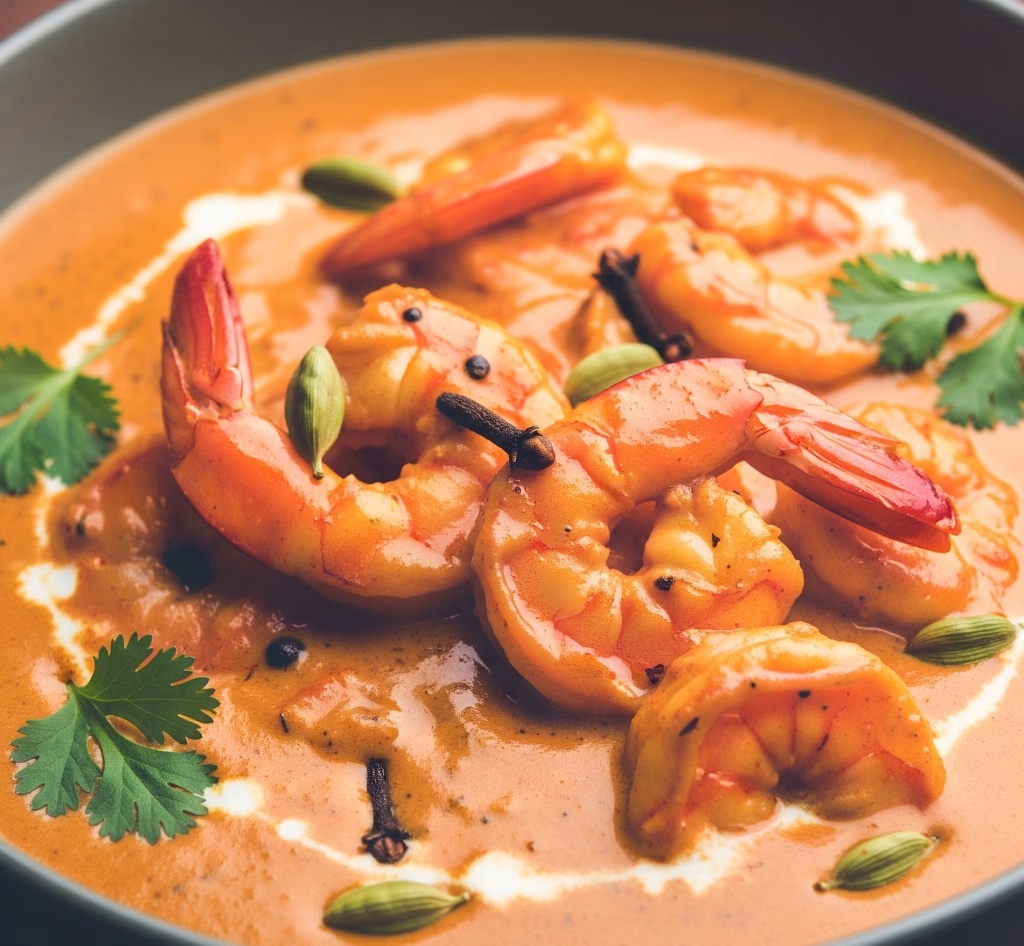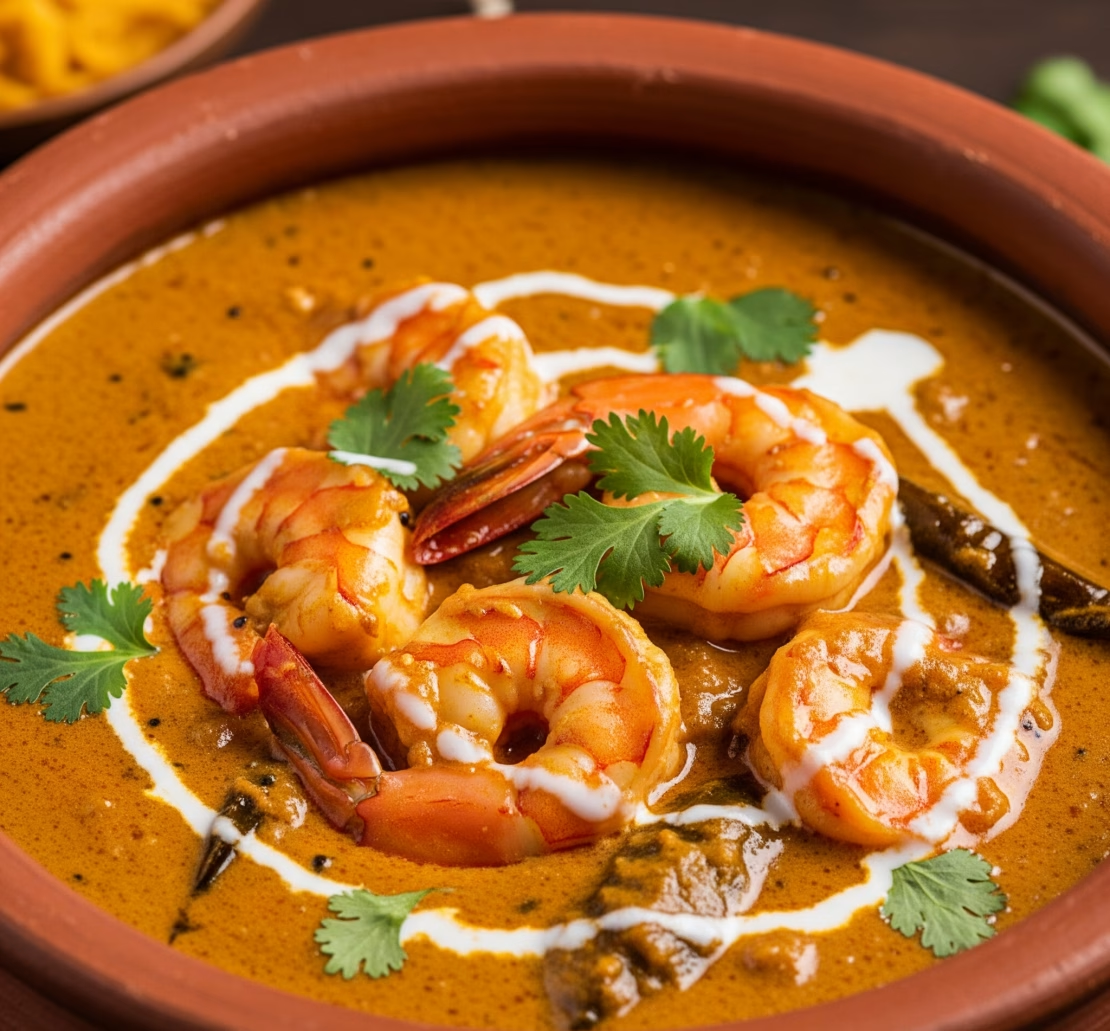Prawn Malai Curry is a luxurious, aromatic Bengali seafood delicacy where succulent prawns are simmered in a creamy coconut milk-based curry infused with fragrant whole spices and subtle heat.
This traditional Indian dish, hailing from the eastern state of West Bengal, strikes a perfect balance between richness and spice, making it a celebration of coastal flavors. Known locally as “Chingri Malai Curry,” this curry is a festival and wedding favorite and holds a beloved spot in every Bengali household. It pairs beautifully with steamed basmati rice, allowing the decadent, coconut-scented gravy to shine.
Table of Contents
Ingredients
For the Prawns:
- 500g (1.1 lb) large prawns or tiger shrimp, shelled and deveined (leave tails on for presentation, optional)
- ½ teaspoon turmeric powder
- ½ teaspoon salt
- 1 tablespoon mustard oil (or vegetable oil)
For the Curry:
- 3 tablespoons mustard oil (or ghee/vegetable oil)
- 1 bay leaf
- 4 green cardamom pods
- 4 cloves
- 1-inch cinnamon stick
- 1 teaspoon cumin seeds
- 2 medium onions, finely chopped
- 1 teaspoon ginger paste
- 1 teaspoon garlic paste
- 2 green chilies, slit
- ½ teaspoon turmeric powder
- ½ teaspoon red chili powder (adjust to taste)
- Salt to taste
- 1 cup thick coconut milk (fresh or canned)
- ½ cup water
- ½ teaspoon sugar (optional, balances flavor)
- 1 tablespoon desiccated coconut or grated fresh coconut (optional)
- 1 tablespoon ghee (for finishing)
- Fresh coriander or fried onions (optional garnish)
Serves
Serves 4 as a main dish with rice
Step-by-Step Instructions
1. Marinate the Prawns
- In a bowl, mix prawns with salt and turmeric.
- Set aside for 10–15 minutes while you prepare other ingredients.
2. Lightly Fry the Prawns
- Heat 1 tablespoon mustard oil in a pan until it begins to smoke slightly (to remove bitterness).
- Sauté the prawns for about 30 seconds on each side or until lightly golden. Do not overcook.
- Remove and set aside.
3. Prepare the Curry Base
- In the same pan, add remaining mustard oil.
- Temper with bay leaf, cardamom, cloves, cinnamon, and cumin seeds.
- Add chopped onions and sauté on medium heat until golden brown (8–10 minutes).
- Stir in ginger and garlic paste; cook until raw smell disappears (2–3 minutes).
- Add slit green chilies.
4. Add Spices
- Sprinkle in turmeric, red chili powder, and salt.
- Stir to mix with onion mixture.
- Add a splash of water to prevent burning and cook for 2–3 minutes until the oil starts to separate.
5. Add Coconut Milk
- Lower the heat and pour in the coconut milk and water.
- Mix gently, scraping the bottom of the pan.
- Let the curry simmer on low for 5–7 minutes until slightly thickened.
6. Add Prawns
- Gently return prawns to the curry.
- Simmer for another 4–5 minutes. Do not overcook—prawns should be juicy and tender.
- Add sugar and stir in grated coconut if using.
7. Finish and Serve
- Turn off the heat and drizzle ghee over the curry.
- Let it rest for a couple of minutes.
- Serve hot over steamed basmati rice.
Serving Suggestions
- Steamed Basmati Rice – The most traditional and ideal pairing.
- Ghee Rice or Coconut Rice – Adds an extra layer of richness.
- Luchi or Puri – Deep-fried Bengali flatbreads for a more festive meal.
- Lemon wedges – To cut the richness.
- Cucumber salad – Refreshing contrast to the creamy curry.
Tips for Perfect Prawn Malai Curry
- Use Fresh Prawns – The fresher the prawns, the sweeter the curry.
- Do Not Overcook – Prawns become rubbery if overcooked. Add them only toward the end.
- Use Thick Coconut Milk – This gives the curry its signature richness.
- Cook Spices Well – Ensures depth of flavor and removes raw taste.
- Smoked Mustard Oil – Authentic Bengali flavor requires smoking mustard oil before use.
- Use Whole Spices – Avoid ground versions for a more aromatic curry.
- Let the Curry Rest – Resting allows the flavors to meld together beautifully.
Healthier Alternatives
- Light Coconut Milk – Reduces calories while keeping the creamy texture.
- Steam or Boil Prawns – Instead of frying for lower fat content.
- Use Olive Oil Instead of Mustard Oil – For a milder and heart-healthier option.
- Reduce Oil Quantity – Use non-stick pans to minimize oil use.
- Serve with Brown Rice or Quinoa – For added fiber and nutrition.
Creative Variations
- Malai Fish Curry – Substitute prawns with boneless white fish like cod or tilapia.
- Vegan Malai Curry – Use tofu or jackfruit instead of prawns.
- Spicy Malai Curry – Add red chili paste or green chili paste for extra heat.
- Prawn Malai Curry with Pineapple – Sweet and tropical twist by adding pineapple chunks.
- Fusion Style – Serve over pasta or use as a filling for wraps and tacos.
Common Mistakes to Avoid
- Overcooking Prawns – Makes them tough and rubbery.
- Using Thin Coconut Milk – Results in a watery and bland curry.
- Skipping the Whole Spices – Reduces depth and authenticity.
- Not Smoking Mustard Oil – Leaves a bitter aftertaste.
- Adding Prawns Too Early – They lose flavor and texture.
- Overpowering with Chilies – Subtle heat is key to this dish.
- Not Sautéing Onions Enough – They should be deeply golden for flavor.
History of Prawn Malai Curry
A Coastal-Bengali Heritage Dish
Prawn Malai Curry originates from Bengal, a region in eastern India renowned for its love of fish and seafood. The word “Chingri” means prawn in Bengali, and “Malai” often refers to “cream,” but in this case, it alludes to the creamy coconut milk base, believed to have been influenced by Southeast Asian and colonial cooking styles.

Colonial and Cultural Influence
During British colonial times, Bengal was a hub of trade and multicultural influence. The use of coconut milk in this dish shows possible Southeast Asian or even Portuguese influence, as coconut-based curries are more common in southern India or tropical regions like Thailand and Malaysia. Over time, this preparation evolved into a luxurious Bengali staple for festive meals.
A Symbol of Celebration
Today, Prawn Malai Curry is a celebrated dish during Bengali weddings, birthdays, and Durga Puja feasts. Its rich and creamy texture, combined with the subtle spice of whole Indian aromatics, makes it a go-to for special occasions. It also showcases the coastal culinary tradition of Bengal in one elegant dish.
FAQs about Prawn Malai Curry
1. Can I use frozen prawns?
Yes, just thaw them completely and pat dry before marinating.
2. What type of coconut milk should I use?
Thick coconut milk (first press or canned) is best for richness.
3. Can I make it ahead of time?
Yes, but add prawns only during reheating to prevent overcooking.
4. Is it very spicy?
No, it has a mild heat. You can adjust the chili quantity to taste.
5. Can I use desiccated coconut instead of fresh?
Yes, but hydrate it in warm water or mix with milk before adding.
6. What can I substitute for mustard oil?
Use ghee or any neutral oil, though mustard oil adds authenticity.
7. Can I make this curry without onions?
You can, but onions add sweetness and body. Try using fewer or blending them smooth.
8. How do I store leftovers?
Refrigerate in an airtight container for up to 2 days. Reheat gently.
9. Can I freeze Prawn Malai Curry?
Yes, but texture may change slightly. Freeze without prawns for better results and add fresh ones later.
10. Is it suitable for children?
Yes, just reduce chili levels and ensure prawns are fully cooked.
Prawn Malai Curry is an iconic Bengali dish that epitomizes comfort, elegance, and culinary depth. With its velvety coconut gravy, tender prawns, and aromatic spices, this dish brings a festive touch to any meal while staying true to its cultural roots. Perfect for special occasions or a luxurious weekend lunch, Prawn Malai Curry offers an authentic taste of eastern India’s rich seafood traditions. With the right balance of spice, sweetness, and creaminess, this dish is bound to impress both seasoned curry lovers and newcomers to Indian cuisine.


